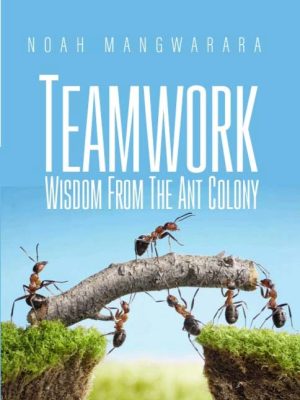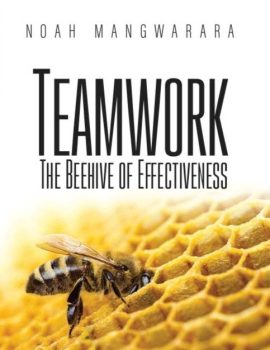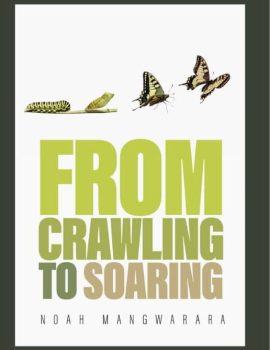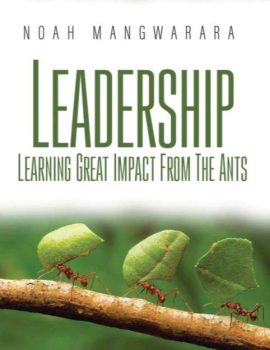Teamwork - Wisdom from the ant colony
Noah Mangwarara continues to draw great lessons from nature. In the mode of King Solomon who would give examples from various animals, insects and trees, Noah shares some teamwork wisdom from the order of the ants. Through the use of inspirational stories and examples from high performance teams, the analogy of the ant is used on how the tiny ants achieve massively as a result of working together with in a team. The author drives one point after another to prove that ants are masters at teamwork. Without working together as a team, there is no way the anthills that are a marvel before us would ever have been constructed. On the same token, no great work was ever achieved by man that didn’t come as a result of teamwork.
Great teamwork goes beyond individual talent, in as much as individual exploits are appreciated. Such individual talent, if not channelled and managed properly, will never amount to much. Great results are always a function of each team member realizing how they have something of value to add for the good and betterment of the team. The book follows through the order of the ants in terms of teamwork and picks up the lessons that can be applied within human teams. It is through the use of these lessons that great results stand to be obtained from the teams around us.
The first chapter starts by challenging the reader that Size doesn’t matter but teamwork does. From the chapter, the author share on how the work ethic of ants is forever amazing, worth emulation. The most fascinating thing is the size of the ant, being so miniature in size, the great accomplishments cannot be ignored. King Solomon, the wisest of the wise could only stand in awe at the order of the ants and he admonished the sluggard to visit the ant and pick some wisdom. Ants remain in a class of their own in the order in which they execute their mandate. Their secret lies in taking advantage of numbers. A single ant will never achieve much but when you bring them together, a work of great art is brought to life.
One of the chapters on Common goals brings the reader to the fact that nothing much is achieved when individuals in a team are busy pulling in different directions to advance their own agenda. It is common cause that people are naturally selfish, being driven primarily by the quest for personal benefit. Even though we are all individually talented, everything in the world points to the need for collaboration. Without bringing together the individual talents and treasures to the common good, it’s almost impossible to achieve much. The quicker team members realize the need for each other, the higher the goal stands to be achieved.
The central part of any team is the purpose or goal as to why the team members came together in the first place. The goal is the draw card that focuses the attention of everyone. The moment it’s called a football team, basketball team or marketing team, that constitute the starting point of delineating what the team stands for and is trying to achieve. It is the understanding of the goal that facilitates prioritization of what can be done and what cannot.
Noah, through his passion for leadership plus a lot of material he has written on the subject, brings to the attention of the reader that it rises and falls on leadership. Every team anywhere is hinged on the capability of its leaders where the difference between two equally talented teams is leadership. Without the leadership mindset, nothing much is ever achieved. Ants, as many as they might be in a colony, are guided by the queen, who acts as the leader of the colony through modelling of the right behaviour for all. The queen produces a special scent called a pheromone. This scent acts as the binding force for all members of the team. Great team leaders have a way of bringing team members together and communicating with them more effectively.
The author indicates how in many sporting disciplines, a coach is fired the moment the team’s performance drops below accepted levels. Interestingly, the team for whom the coach is replaced tends to transform as though by magic. This goes to show the importance of leadership to the team.
Of importance in the team is the realization that everyone ought to function as a leader. Everyone is mandated to make choices that affect them and the team within their area of expertise. A coach can set the standards of operation, inspire the team and communicate in the best way possible to produce the intended outcome but the outcome is dependent on the decisions made on the field of play. The result can turn out to be way below what is expected. The explanation comes in self-leadership as it relates to each individual teammate. Leadership should never be limited to the one with a position. A coach does not kick the ball in the field of play. The player on the pitch is the one making choices that contribute to the result. Such players ought to be leaders in their individual rights. This is the essence of ant colony leadership where each ant has a mandate to execute within her space as a leader who makes a positive contribution for the good of all.
With one principle after another shared in an interesting to read fashion, the points are driven home. Team members and team leaders alike stand to benefit from this masterpiece of teamwork by a wisdom packed author.




